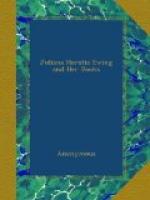[Footnote 20: Included in “The Human Face Divine, and other Tales.” By Margaret Gatty. Bell and Sons.]
One of her favourite methods for practising drawing was to devote herself to thoroughly studying the sketches of some one master, in order to try and unravel the special principles on which he had worked, and then to copy his drawings. She pursued this plan with some of Chinnery’s curious and effective water-colour sketches, which were lent to her by friends, and she found it a very useful one. She made copies from De Wint, Turner, and others, in the same way, and certainly the labour she threw into her work enabled her to produce almost facsimiles of the originals. She was greatly interested one day by hearing a lady, who ranks as one of the best living English writers of her sex, say that when she was young she had practised the art of writing in just the same way that Julie pursued that of drawing, namely, by devoting herself to reading the works of one writer at a time, until her brain was so saturated with his style that she could write exactly like him, and then passing on to an equally careful study of some other author.
The life-like details of the “cholera season,” in the second chapter of “Six to Sixteen,” were drawn from facts that Major Ewing told his wife of a similar season which he had passed through in China, and during which he had lost several friends; but the touching episode of Margery’s birthday present, and Mr. Abercrombie’s efforts to console her, were purely imaginary.
Several of the “Old-fashioned Fairy Tales” which Julie wrote during this (1872) and previous years in Aunt Judy’s Magazine, were on Scotch topics, and she owed the striking accuracy of her local colouring and dialect, as well as her keen intuition of Scotch character, to visits that she paid to Major Ewing’s relatives in the North, and also to reading such typical books as Mansie Wauch, the Tailor of Dalkeith, a story which she greatly admired. She liked to study national types of character, and when she wrote “We and the World,” one of its chief features was meant to be the contrast drawn between the English, Scotch, and Irish heroes; thanks to her wide sympathy she was as keenly able to appreciate the rugged virtues of the dour Scotch race, as the more quick and graceful beauties of the Irish mind.
[Illustration: AMESBURY]
The Autumn Military Manoeuvres in 1872 were held near Salisbury Plain, and Major Ewing was so much fascinated by the quaint old town of Amesbury, where he was quartered, that he took my sister afterwards to visit the place. The result of this was that her “Miller’s Thumb"[21] came out as a serial in Aunt Judy’s Magazine during 1873. All the scenery is drawn from the neighbourhood of Amesbury, and the Wiltshire dialect she acquired by the aid of a friend, who procured copies for her of Wiltshire Tales and A Glossary of Wiltshire Words and Phrases,




